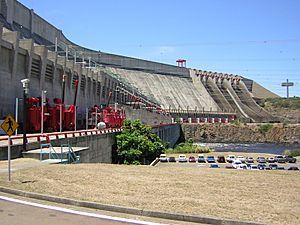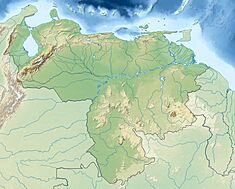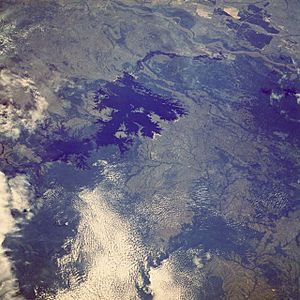Guri Dam facts for kids
Quick facts for kids Simón Bolívar Hydroelectric PlantGuri Dam |
|
|---|---|
 |
|
|
Location of Simón Bolívar Hydroelectric Plant
Guri Dam in Venezuela |
|
| Official name | Central Hidroeléctrica Simón Bolívar |
| Location | Necuima Canyon, Bolívar |
| Coordinates | 07°45′N 63°00′W / 7.750°N 63.000°W |
| Status | In use |
| Construction began | 1963 |
| Opening date | 1978 |
| Owner(s) | CVG Electrificación del Caroní, C.A. |
| Dam and spillways | |
| Type of dam | Gravity/embankment |
| Impounds | Caroni River |
| Height | 162 m (531 ft) |
| Length | 7,426 m (24,364 ft) |
| Dam volume | Concrete: 6,026,000 m3 (212,806,182 cu ft) Earth: 23,801,000 m3 (840,524,383 cu ft) |
| Spillway type | Service, controlled crest overflow |
| Spillway capacity | 27,000 m3/s (953,496 cu ft/s) |
| Reservoir | |
| Creates | Guri Reservoir |
| Total capacity | 135,000,000,000 m3 (109,446,281 acre⋅ft) |
| Surface area | 4,250 km2 (1,641 sq mi) |
| Power station | |
| Turbines | Francis Turbines. 10 × 725 MW 4 × 180 MW 3 × 400 MW 3 × 225 MW 1 × 340 MW |
| Installed capacity | 10,235 MW |
| Annual generation | 47,000 GWh |
The Simón Bolívar Hydroelectric Plant, also known as the Guri Dam (Spanish: Central Hidroeléctrica Simón Bolívar or Represa de Guri), is a huge dam in Bolívar State, Venezuela. It was built on the Caroni River between 1963 and 1969. This dam is very long, stretching for 7,426 meters (about 4.6 miles), and stands 162 meters (about 531 feet) tall.
It holds back a massive amount of water, creating the Guri Reservoir. This reservoir is one of the biggest man-made lakes in the world! The Guri Dam uses the power of this water to create electricity for Venezuela and even some neighboring countries. It was once the largest hydroelectric power station globally, but now others like the Itaipu Dam are bigger.
Contents
Building the Guri Dam
Engineers started studying the idea for the Guri Dam in 1961. They wanted to see if it was possible and how much it would cost. An international group of companies was chosen to build the dam. Construction began in 1963 in the Necuima Canyon. This canyon is about 100 kilometers (62 miles) upstream from where the Caroní River meets the Orinoco River.
By 1969, the first part of the dam was finished. It was 106 meters (348 feet) high and 690 meters (2,264 feet) long. This created a large lake called the Guri Reservoir. It is the biggest freshwater lake in Venezuela. The power station at that time could produce 1,750 megawatts (MW) of electricity. By 1978, it was upgraded to produce 2,065 MW using ten turbines.
Expanding the Dam
Because Venezuela needed more electricity, a second building stage began in 1976. Workers built a much longer dam section, about 1,300 meters (4,265 feet) long. They also added another way for excess water to flow out (called a spillway). A second power station was built with ten more turbines, each producing 725 MW.
These additions made the dam even bigger. It grew to 162 meters (531 feet) high and 7,426 meters (24,364 feet) long. The water level in the reservoir also rose, making the lake even larger. It could now hold 138 billion cubic meters of water. The completed dam was officially opened on November 8, 1986.
Since 2000, there has been a project to update and improve the Guri Power Plant. This work helps the plant keep running for another 30 years. They are replacing parts in the power stations to make them more efficient.
Power Problems and Blackouts
Why Venezuela Relies on Guri
For many years, Venezuela's government wanted to use less fossil fuels (like oil) to make electricity. This was so they could sell more oil to other countries. Because of this, about 74% of Venezuela's electricity comes from renewable energy, mostly hydroelectric power like the Guri Dam.
By 2006, the Guri Dam alone provided more than one-third of all the electricity in Venezuela. Some of this power is even sent to neighboring countries like Colombia and Brazil. However, relying so much on one source can be risky.
Electricity Shortages in 2010
In 2010, Venezuela faced a long period without much rain, called a drought. The water levels behind the Guri Dam became very low. This meant the dam could not produce enough electricity for everyone. To save power, the government had to turn off electricity in different areas at different times. These were called rolling blackouts.
Electricity Shortages in 2016
In April 2016, low water levels happened again. The government announced blackouts for four hours a day, which lasted for 40 days. To save power, government workers were told not to come to work on Fridays. The president even asked people not to use hair dryers! Electricity was also limited for large shopping malls. The Easter holiday was made longer to help save power.
Major Blackout in 2019
On March 7, 2019, the Simón Bolívar Hydroelectric Plant stopped working. This caused most of Venezuela's 32 million people to lose electricity. For several days, attempts to restart the main power distribution station failed.
Government officials said the blackout was caused by "sabotage." However, many experts believed it was due to old equipment and not enough maintenance at the power plant.
See also
 In Spanish: Central Hidroeléctrica Simón Bolívar para niños
In Spanish: Central Hidroeléctrica Simón Bolívar para niños



